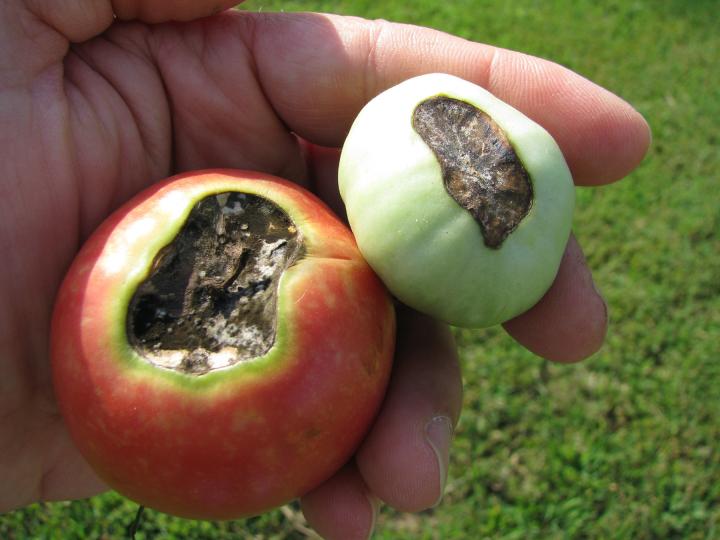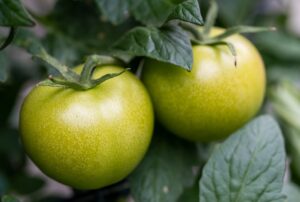Blossom end rot is a common condition found in tomatoes, peppers, cucumbers, eggplant, melons, and squashes, like zucchini. It is characterized by a water-soaked spot or lesion located at or near the bottom of the fruit.
Blossom end rot is not a disease but rather a physiological disorder (or an abiotic disorder) caused by a calcium imbalance. The lesion will enlarge and become dark brown and somewhat leathery looking. Often, pathogens like fungi and bacteria will take advantage of the decaying fruit. This secondary condition is usually characterized by a black, fuzzy growth.
Since blossom end rot (BER) is not a disease, it will not spread from fruit to fruit or from plant to plant. But the same conditions that caused the rot may appear on fruit from the same plant or on plants that are experiencing the same growing conditions.
How to Diagnose BER
Symptoms of blossom end rot are easy to identify. A lesion begins as a dry, light green to yellow spot located at the bottom of the fruit, often the plant’s first fruit of the season. In the early stages, the lesion may be misdiagnosed as sun scald, a condition caused by overexposure to the sun. As BER worsens, the spot will darken in color from tan to brown to black. It may also become sunken.
In addition to BER, internal blossom end rot can occur, which means you will not be aware of the lesion until you cut into the produce. Internal blossom end rot may also be noticeable on the exterior sides of the fruit.
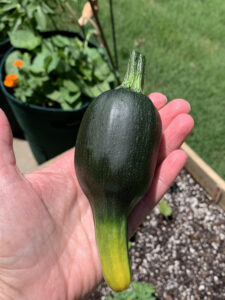
What Causes Blossom End Rot?
Calcium is a mineral that plays a role in cell formation and division, metabolizing nitrogen, and setting fruit. This macronutrient is necessary for plants to grow and for fruit and seeds to develop. (You can learn more about micro and macronutrients in this helpful article.) Nitrogen, phosphorus, and potassium (NPK) are mobile nutrients that, once taken up by the roots, can be transported to various parts of the plant as needed. Calcium, on the other hand, is not mobile. If calcium is not available when plants are setting fruit, blossom end rot will occur.
This article contains affiliate links. If you make a purchase using one of these links, I will receive a very small commission at no additional cost to you, and it will help me maintain this website. Rest assured, I only recommend products I actually like!
The primary cause of BER is insufficient calcium, either a lack of calcium in the soil or the inability of calcium present in the soil to be taken up by the plant’s roots. To determine if such a deficiency exists in the soil, a soil test must be performed. Most at-home soil test kits only test for soil pH, nitrogen, phosphorus, and potassium levels (NPK). However, there is a test kit available online that, in addition to NPK, can also test for calcium and other micronutrients. It involves sending in samples to the manufacturer’s lab, which will, in turn, send you the results digitally along with recommendations for amendments if needed. Alternatively, you can contact your local agricultural extension office, which can perform similar tests for little to no charge, although it may take longer.
However, most often, the problem is not due to insufficient calcium in the soil but rather the plant’s inability to absorb calcium that is present in the soil.
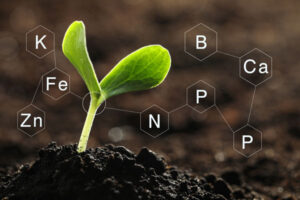
What Inhibits Calcium Uptake?
There are several factors that can affect a plant’s ability to take up calcium.
1. Inconsistent Soil Moisture
The most frequent cause of a plant’s inability to absorb calcium is fluctuations in soil moisture due to inconsistent watering. Plants require even, consistent watering in order for calcium to be taken up by the plant. Even though calcium is present in the soil, inconsistent or inadequate watering can inhibit calcium uptake.
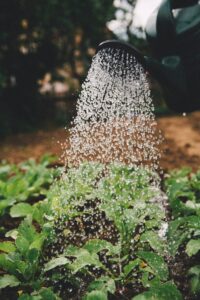
2. Root Damage
Another cause of BER is damaged roots. The damage may be a result of manual pruning, improper fertilization resulting in a root chemical burn, or root rot from being waterlogged. Regardless of the reason, root damage can restrict calcium uptake, which will result in BER.
3. Improper Soil pH
Soil pH is very important for plant health. (You can learn more about the importance of soil pH in this helpful article.) A soil pH that is either too high or too low could result in the plant’s inability to take up calcium that is present in the soil. You can easily test your soil’s pH using a test kit. Here is the test kit I use. Thankfully, soil pH can be corrected. Here is how to correct soil pH if it is too high (too alkaline) or too low (too acidic).
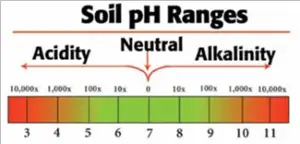
4. Excessive Nitrogen
As calcium is absorbed from the soil, it moves to various parts of the plant through transpiration, which is the release of water vapor through plant tissue stomata or pores. (See this article on plant edema for more information on transpiration.) Available calcium moves more readily to leaves because they transpire more water than fruits do. Because calcium is an immobile nutrient, it will remain in the leaves and not be reallocated to fruit.
Nitrogen promotes leafy growth. So, when excessive nitrogen is applied to the plant due through improper fertilization, more calcium is directed toward the leafy growth, further exacerbating the lack of calcium to the fruit and promoting blossom end rot.
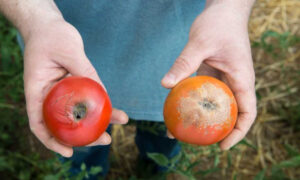
5. Cold Soil
Many gardeners understand that soil temperature is an important factor in seed germination (you can learn more about this topic here), but soil temperature also plays a role in a plant’s ability to absorb calcium and other important nutrients. Cold soil inhibits calcium uptake. Thus, if your plant is exhibiting BER, it is possible that it was planted too early, or that your area experienced an unexpected cold snap.
6. High Level of Salts in the Soil
When fertilizers are used in excess, the result can be high levels of soluble salts in the soil. The high concentration of salts can draw water away from the roots making it more difficult for them to absorb calcium.
How to Treat Blossom End Rot
Blossom end rot is not caused by an insect or pathogen like bacteria or fungi; therefore, it cannot be treated by using insecticides or fungicides like neem oil. Thankfully, however, there are effective ways to treat the problem.
1. Remove the Produce
Produce affected by BER will not be able to recover. Thus, you will need to remove the produce so that the plant can redirect its energy to other parts of the plant.
Another reason to remove the fruit is that bacteria and fungi can use the decayed tissue as an entry point, causing a secondary issue.
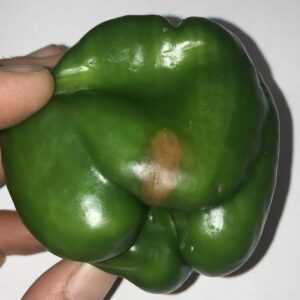
2. Water Consistently
Make sure plants are receiving adequate and consistent watering. Try adding mulch to help retain moisture.
3. Apply a Calcium Slurry
Apply a calcium slurry to affected plants as a sort of emergency measure. You can use products like Rot-Stop, or you can make your own by mixing 1 tablespoon of calcium chloride in one gallon of water. Use a gallon sprayer to apply the mixture to the foliage 2 to 3 times per week until the problem is resolved. Spray early in the morning to prevent scorching the leaves and to keep the treatment from evaporating too quickly.
Can You Eat Produce with Blossom End Rot?
You can consume the portion of the produce that has not been affected by BER. Note, however, that the overall quality and quantity of future produce from the plant will decrease unless the condition is addressed.
How to Prevent Blossom End Rot
1. Soil Preparation
It is always best to prevent a problem than it is to remedy it. So how do you prevent BER? The most effective way to prevent this problem is to prepare the soil.
Perform a soil pH test to make sure it is a proper pH for the type of plant you want to grow. Typically, this will be between 6.0 and 6.5.
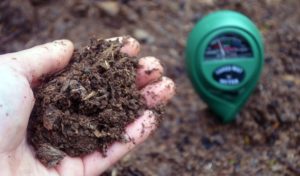
Add bone meal, oyster shell, garden lime, or gypsum, preferably two to four months prior to planting. Crushed clean egg shells can also work as a way to pre-treat the soil with calcium. Also, wait until the soil temperature is warm enough to plant the desired crop.
2. Water Consistently
Perhaps the most important step in preventing BER is to water the soil consistently, keeping it evenly moist and not soggy. You can add a layer of mulch to help the soil retain moisture in between watering. A drip irrigation system or soaker hoses can also help maintain consistent moisture levels.
3. Use Appropriate Fertilizer
Fertilizers that are higher in nitrogen can be beneficial to crops like broccoli, but many vegetable crops like tomatoes, peppers, carrots, etc., require more phosphorus than nitrogen. This is the fertilizer I use for crops like tomatoes and peppers.
In addition, to using the proper type of fertilizer, it is also important not to over-fertilize, as this can cause problems as well.
4. Plant Tolerant Cultivars
Choose vegetable cultivars (plant varieties) that are more tolerant of calcium deficiencies and, therefore, less likely to develop blossom end rot. Indeterminate varieties of tomatoes, for example, are less likely to succumb to BER than determinate varieties because they produce fruit over a longer period of time and, thus, are better at regulating their calcium needs.
The University of Illinois performed a study that identified tomato varieties that have a lower incidence of BER. These varieties include Celebrity, Freak Pak, Jet Star, Manapal, Mountain Pride, Pik Red, Sunny, and Winter.
Conversely, they determined the following varieties of tomatoes had a high incidence of BER: Big Boy, Castle King, Fantastic, Independence, Supersonic, Surprise, Whopper, and Wonder Boy.
Does Epsom Salt Cure Blossom End Rot?
Contrary to popular practice, Epsom salt does not cure BER. (Learn the basic science behind why it does not work in this helpful article.) In fact, Epsom salt, also known as magnesium sulfate, could make the problem worse. That is because magnesium sulfate and calcium ions compete for space both in the soil and in the plant. Thus, if you add Epsom salt, you are giving magnesium an advantage and, in effect, displacing much needed calcium. (You can learn more about a magnesium deficiency here.)
Now that you have learned what blossom end rot is and how to not only treat it but also prevent it, you will be able to enjoy a more productive harvest!
Thank you for reading this article! If you found it helpful, please consider sharing it with others via email and social media!
